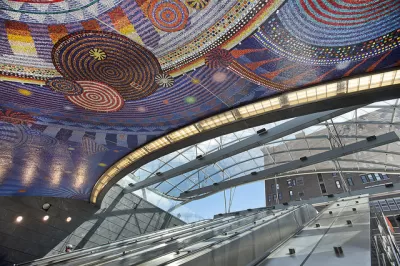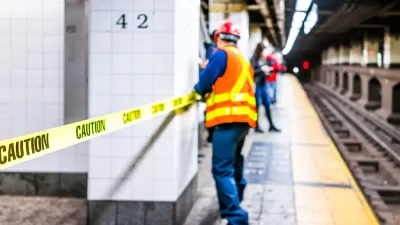On Sept. 13, the Hudson Yards Subway Station, the new Manhattan terminal for the #7 line that terminates in Flushing, Queens, will open with a grand ribbon-cutting ceremony considering the $2.4 billion cost for the one mile extension.

The new No. 7 station at 34th Street and11th Avenue "is expected to initially attract about 32,000 passengers each weekday," writes Emma G. Fitzsimmons for The New York Times. "Because tracks were built as far south as 25th Street, the Metropolitan Transportation Authority (MTA) will have more space to store trains, which officials said would improve service for all No. 7 train riders."
The train currently terminates at the city's busiest subway station at Times Square—42nd Street / Port Authority Bus Terminal on Seventh and Eighth Avenues, and Broadway in Midtown Manhattan," per Wikipedia.

Image credit: Metropolitan Transportation Authority of the State of New York (via Flickr).
San Francisco, where a new plan to build-out its own limited subway using largely local funding was warmly received, should take notice of the new station for another reason: "It is the first subway extension paid for by the city in more than 60 years," notes Fitzsimmons.
Eric Jaffe of CityLab describes the "innovative funding scheme" used to finance the extension financing:
[Former Mayor Michael] Bloomberg wanted the 7 train so badly that rather than wait for the MTA to drum up the money (he’d still be waiting), the administration said the city itself would foot the bill. The funding structure they devised, known as “tax incremental financing,” was an innovative one—at least by the standards of U.S. transportation funding. The city issued bonds for the construction to be repaid by future tax revenue from developers whose property value would soar once the extension was complete.
The scheme works since Hudson Yards is such a massive project, as Planetizen contributing editor Philip Rojc notes in his June 30 post on the development, explaining why TIF financing made sense.
"Development on the West Side is generating so much money in fees and taxes, officials say, that for the first time in a decade, the city will not have to take money out of its budget to make payments on the $3 billion in bonds used to build parks and a subway line in the district."
Gov. Andrew Cuomo may cite the self-financing as reason why the City needs to contribute more to close M.T.A's funding gap, an on-going state-city conflict.
Construction has been underway since 2007 during which time the neighborhood has undergone a "drastic makeover," writes Fitzsimmons.
In what was once a desolate industrial area, cranes dot the skyline as buildings sprout in the Hudson Yards district, which is roughly west of Eighth Avenue between 30th and 42nd Streets. The Jacob K. Javits Convention Center received a nearly half-billion dollar renovation, and tourists flock to the nearby High Line.
Click here to read Jaffe's six other "fun facts about the new 7 Train extension."
FULL STORY: No. 7 Subway Station to Open on Far West Side After Series of Delays

Alabama: Trump Terminates Settlements for Black Communities Harmed By Raw Sewage
Trump deemed the landmark civil rights agreement “illegal DEI and environmental justice policy.”

Study: Maui’s Plan to Convert Vacation Rentals to Long-Term Housing Could Cause Nearly $1 Billion Economic Loss
The plan would reduce visitor accommodation by 25% resulting in 1,900 jobs lost.

Planetizen Federal Action Tracker
A weekly monitor of how Trump’s orders and actions are impacting planners and planning in America.

Wind Energy on the Rise Despite Federal Policy Reversal
The Trump administration is revoking federal support for renewable energy, but demand for new projects continues unabated.

Passengers Flock to Caltrain After Electrification
The new electric trains are running faster and more reliably, leading to strong ridership growth on the Bay Area rail system.

Texas Churches Rally Behind ‘Yes in God’s Back Yard’ Legislation
Religious leaders want the state to reduce zoning regulations to streamline leasing church-owned land to housing developers.
Urban Design for Planners 1: Software Tools
This six-course series explores essential urban design concepts using open source software and equips planners with the tools they need to participate fully in the urban design process.
Planning for Universal Design
Learn the tools for implementing Universal Design in planning regulations.
Caltrans
Smith Gee Studio
Institute for Housing and Urban Development Studies (IHS)
City of Grandview
Harvard GSD Executive Education
Toledo-Lucas County Plan Commissions
Salt Lake City
NYU Wagner Graduate School of Public Service




























